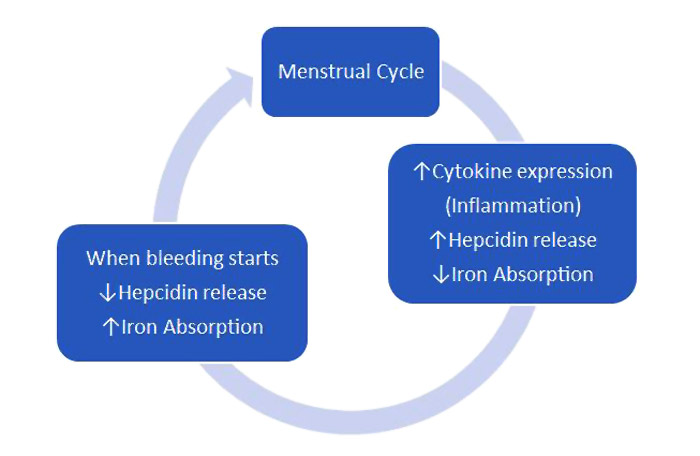Risk of low iron status, effect on performance and best practice guidelines for athletes
The major function of iron in the body is in the formation of haemoglobin and other compounds that are essential for the transport and utilization of oxygen. Iron is also an important requisite component of cytochromes and enzymes within the mitochondria, making iron an essential component for brain development and cognitive performance in athletes.
It is well known that athletes are at greater risk of iron deficiency than the general population. For the athlete, the reduction of iron stores could have effects on the capacity for oxygen transport, athlete motivation, concentration and hence decision making during play. Therefore, iron levels in athletes should be managed to ensure their performance is maximized. In the management of body iron levels, it is important to understand the role of the hormone hepcidin in iron metabolism.
The Role of Hepcidin in Iron Metabolism
Fairly recently, scientists have discovered the hormone Hepcidin, which regulates systemic iron homeostasis. Circulating high levels of this hormone:
- Inhibit intestinal iron absorption
- Degrade ferroportin (cellular iron export protein)
- Decrease numbers of macrophages and iron recycling
- Release iron from storage form into the bloodstream
…all with the aim to reduce iron stores to prevent overload, which has adverse effects on the body.
Hepcidin production is increased by:
- Iron overload
- Chronic infection or Inflammation, and
- Chronic or acute high intensity or endurance exercise
Hepcidin production is reduced when:
- Body iron requirements are high, e.g. during periods of growth, and
- Iron stores are very low
It is well now that exercise causes an inflammatory response. One of the end results of this is increases in Interleukin-6 (IL-6), in turn increasing the production of hepcidin, which causes a reduction in iron absorption.
Hepcidin levels peak approximately 3–6 hours after exercise. Therefore, heavy and frequent exercise training bouts may put the athlete at further risk of iron deficiency.
 Acute high intensity or endurance exercise increases Hepcidin production
Acute high intensity or endurance exercise increases Hepcidin productionExercise Modality on Hepcidin Changes
All of the following papers showed significant elevation of hepcidin levels post-exercise with the listed exercise regimes:
- Domínguez et al. (2014) for exercise at an intensity of over 65% VO2max
- Sim et al. (2017) using 4 different scenarios
- High-intensity interval cycling and running: 8 × 3-min at 85% VO2peak
- Low-intensity cycling and running: 40mins continuous at 65% VO2peak
- Dahlquist et al. (2017) used 8-min cycle warm-up at 50% pV˙O2max, cycle test of 8 × 3-min at 85% pV˙O2max with a 1.5-min active recovery (60% pV˙O2max) separating the bouts, 8-min cool-down at 50% pV˙O2max
- Peeling et al. (2017) used an elite cohort of internationally competitive athletes, ~120-min endurance exercise resulting in a 7.5-fold increase to hepcidin
The bottom line is: The longer the duration of exercise or the greater the intensity the greater the impact on the rise of hepcidin levels.
Current Iron Status on Hepcidin Changes
Baseline iron status appears to play a dominant role in the regulation of hepcidin. The greater the baseline iron stores the more magnified the post-exercise hepcidin response will be. Serum ferritin concentration has the largest effect (~47%), and serum iron levels (~39%) of the underlying variation (Peeling et al. 2017).
Low iron stores can cause a downregulation of hepcidin synthesis to encourage iron absorption and recycling, which is the body’s protective response to help to improve iron status. Athletes with sub-optimal iron stores (serum ferritin ~30–50 μg/L) may be at greatest risk, as they will generate post-exercise hepcidin elevation and compromise their ability to absorb dietary iron intake (Peeling et al. 2017).
Different Nutrient Influences on Hepcidin
There has been some previous evidence that Vitamin D supplementation can affect hepcidin levels in non-athletic populations. Recently though, Dahlquist et al. (2017) studied the effects of CHO, PTN, Vitamin D, and Vitamin K supplementation on hepcidin response in athletes. Vitamin D did not affect hepcidin in this research, possibly due to the shorter supplementation period used, the lower dosage used than previous studies, as well as the fact that all the athletes in the study were Vitamin D sufficient, and not deficient as has been in previous studies. More research is required in this area, however the potential for a downstream effect on iron status is exciting (Pedlar et al 2018).
Post-exercise carbohydrate ingestion does not appear to impact post-exercise interleukin-6 and hepcidin responses (Badenhorst 2015).
Iron supplements acutely increase hepcidin production. Therefore, providing lower dosages (40-80 mg Fe) and avoiding twice-daily dosing can maximise fractional absorption. The duration of the hepcidin response supports alternate day supplementation, but longer-term effects of these schedules require further investigation (Moretti et al. 2015).
The Female Effect
Females are at particular risk of iron deficiency due to blood loss during menstruation, especially those with heavy bleeding.

The menstrual cycle influences cytokine production, causing inflammation at different times in the female athlete cycle (Pedlar 2018) influencing the hepcidin response.
Screening Recommendations
Sports Science and Sports Medicine disciplines working with athletes or a team of athletes need to be aware of an athletes’ iron status, to best manage health and performance, since both are affected with low iron stores. To achieve the best management of this situation, the following is a recommendation of what should be implemented:
- Identification of iron deficiency with screening blood tests checking full blood count. The best time to screen is at the beginning of an athlete’s season, e.g. at the onset of pre-season for team sports. For the year-round athletes before a heavy training load would be ideal, as well as before heading to altitude for any training.
- If screening is not possible, on demonstration of symptoms of fatigue, or an increased rate of illness or infections, follow up blood tests are recommended to check iron status
- Treatment for at-risk athletes would include IV infusion if deemed necessary by the physician working with the athlete, oral supplementation second daily or lower daily doses, as well as a full dietary review to recommend changes to improve iron intake and absorption.
Main Findings and Practical Consequences
- Athletes who train at moderate to high-intensity levels will see an effect on their hepcidin response post activity. With the highest risk being at times when intensity is the greatest during an athlete’s activity cycles.
- As well as the usual treatment for athletes with very low ferritin levels (<30 μg), one group to look out for are athletes that have suboptimal ferritin levels (30-50 μg/L), as his group is most affected by the hepcidin increases.
- Need to address a female athletes’ menstrual cycle details, either with more in-depth consultations by the doctor or sports dietitian.
- Vitamin D could be an area of interest in the future.
- Main strategies to include nutrition therapy:
- Increasing red meat and other iron-rich foods in the diet
- Consuming vitamin C with meals to enhance absorption
- Placing main iron-rich meals, and supplementation on non-training days
- Supplementation second daily, or at a lower dosage could help absorption
- Avoiding tea and coffee, and excessive fibre with meals.
References
- Peeling, P. Exercise as a mediator of hepcidin activity in athletes. Eur J Appl Physiol (2010) 110:877–883.
- Peeling P, McKay A, Pyne D, Guelfi K, McCormick R, Laarakkers C, Swinkels D, Garvican-Lewis L, Ross M, Sharma A, Leckey J, Burke LM. Factors influencing the post-exercise hepcidin-25 response in elite athletes. Eur J Appl Physiol (2017) 117:1233–1239.
- Sim M, Dawson B, Landers G, Swinkels DW, Tjalsma H, Trinder D, Peeling P. Effect of Exercise Modality and Intensity on Postexercise Interleukin-6 and Hepcidin Levels. Int J Sport Nutr Exerc Metab. 2013 Apr;23(2):178-86.
- Peeling P, Sim M, Badenhorst CE, Dawson B, Govus AD, Abbiss CR, Swinkels DW, Trinder D. Iron status and the acute post-exercise hepcidin response in athletes. PLoS One. 2014 Mar 25;9(3):e93002. doi: 10.1371/journal.pone.0093002.
- Domínguez et al. [Effect of hepcidin on iron metabolism in athletes]. Nutr Hosp. 2014 Dec 1;30(6)
- Badenhorst CE, Dawson B, Cox GR, Laarakkers CM, Swinkels DW, Peeling P. Timing of post-exercise carbohydrate ingestion: influence on IL-6 and hepcidin responses. Eur J Appl Physiol. 2015 Oct;115(10):2215-22.
- Charles R Pedlar, Carlo Brugnara, Georgie Bruinvels & Richard Burden. Iron balance and iron supplementation for the female athlete: A practical approach. European Journal of Sport Science, 18:2 (2018).
- Sim M, Dawson B, Landers G, Swinkels DW, Wiegerinck E, Yeap BB, Trinder D, Peeling P. Interleukin-6 and Hepcidin Levels during Hormone-Deplete and Hormone-Replete Phases of an Oral Contraceptive Cycle: A Pilot Study. Ann Nutr Metab. 2017;70(2):100-105.
- Moretti D, Goede JS, Zeder C, Jiskra M, Chatzinakou V, Tjalsma H, Melse-Boonstra A, Brittenham G, Swinkels DW, Zimmermann MB. Oral iron supplements increase hepcidin and decrease iron absorption from daily or twice-daily doses in iron-depleted young women. Blood. 2015 Oct 22;126(17):1981-9.
Related Pages
- About Iron & Athletes
- Macronutrients for athletes
- Blood testing for athletes
- All about Sports Nutrition


 Current Events
Current Events